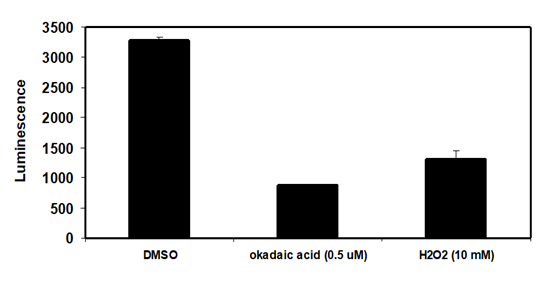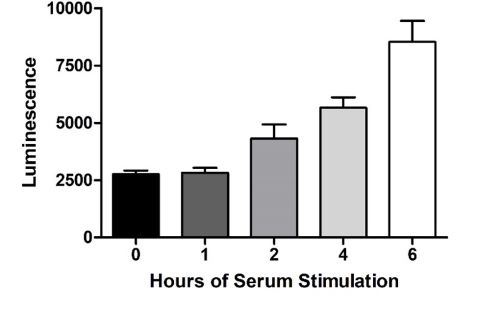Hippo Pathway/TEAD Luciferase Reporter MCF7 Cell Line
The TEAD Luciferase Reporter MCF7 cell line contains the firefly luciferase gene under the control of TEAD responsive elements stably integrated into the human breast cancer cell line MCF7. When the Hippo pathway is not stimulated, transcriptional coactivators YAP (Yes-associated protein) and TAZ (also known as WWTR1, WW domain containing transcription regulator 1) are localized in the nucleus and induce constitutive expression of the luciferase reporter. The cell line has been validated for the inhibition of the luciferase reporter by activators of the Hippo pathway, and for the activation of the luciferase reporter by inhibitors of the Hippo pathway.
Interested in screening and profiling activators of the Hippo pathway without the need to purchase and license the cell line? Check out our Cell Signaling Pathway Screening.
This product has been cited 7 times.
Purchase of this cell line is for research purposes only; commercial use requires a separate license. View the full terms and conditions.
Materials Required for Cell Culture
| Name | Ordering Information |
| Thaw Medium 1 | BPS Bioscience #60187 |
| Growth Medium 1B | BPS Bioscience #79531 |
| Insulin Solution from Bovine Pancreas | Sigma-Aldrich #I0516 |
Materials Used in the Cellular Assay
| Name | Ordering Information |
| Thaw Medium 1 | BPS Bioscience #60187 |
| Insulin Solution from Bovine Pancreas | Sigma-Aldrich #I0516 |
| Okadaic acid (stock 10 mM in DMSO) | BPS Bioscience #27047 |
| H2O2 | |
| ONE-Step™ Luciferase Assay System | BPS Bioscience #60690 |
| 96-well tissue culture-treated white clear-bottom assay plate | |
| Luminometer |
The cell line has been screened to confirm the absence of Mycoplasma species.
The Hippo cell signaling pathway regulates organ size and acts as a tumor suppressor by suppressing the transcription of genes controlled by transcription factor TEAD (Transcriptional enhancer factor TEF-1). The Hippo pathway is activated by high cell density and cellular stress to stop cell proliferation and induce apoptosis. Activation of this pathway triggers a kinase cascade in which MST (Macrophage-stimulating) kinases phosphorylate LATS (Large tumor suppressor) kinases, which then phosphorylate transcriptional co-activators YAP and TAZ. In unstimulated cells, dephosphorylated YAP and TAZ are localized in the nucleus and interact with TEAD transcriptional factors to induce cell cycle-promoting gene transcription. Upon stimulation of the Hippo pathway, newly phosphorylated YAP and TAZ are sequestered in the cytosol, and TEAD-dependent gene transcription is turned off. Dysfunction of the Hippo pathway is frequently detected in human cancer and correlates with cancer aggressiveness and poor prognosis.
1. Lamar JM et al. (2012) The Hippo pathway target, YAP, promotes metastasis through its TEAD-interaction domain. Proc Natl Acad Sci U S A. 109(37):E2441-50. doi: 10.1073/pnas.1212021109.
2. Hata Y et al. (2013) Okadaic Acid: a tool to study the hippo pathway. Mar Drugs. 11(3):896-902. doi: 10.3390/md11030896.
3. Bao Y et al. (2011) A cell-based assay to screen stimulators of the Hippo pathway reveals the inhibitory effect of dobutamine on the YAP-dependent gene transcription. J Biochem. 150(2):199-208.





